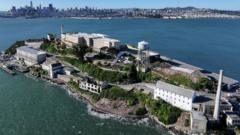Donald Trump's controversial proposition to revive Alcatraz, the infamous island prison in San Francisco Bay, has sparked significant discussion. The former president believes that reopening Alcatraz could demonstrate a commitment to law and order by housing dangerous inmates. However, many experts argue that the idea is completely unrealistic. Alcatraz, once home to notorious criminals like Al Capone, has been largely preserved as a museum and a tourist attraction, drawing millions annually.
Originally built as a naval fort, Alcatraz was transformed into a military prison before becoming a federal facility in 1934. It closed in 1963 due to high operating costs—three times more than other federal prisons—and is owned by the National Park Service today. Christine Lehnertz from the Golden Gate National Parks Conservancy has emphasized the significance of Alcatraz as a historical site and the lessons it imparts.
Trump's fascination with the prison isn't new; previous administrations have considered it for various uses, including as a detention center for Cuban refugees. Recently, the former president voiced the need to effectively combat violent crime in America through a Truth Social post, sparking renewed interest in the site. Critics quickly responded. Chad Gilmartin from the Justice Department remarked on efforts to restore Alcatraz but faced pushback from various experts, including Hugh Hurwitz, a former acting director of the Bureau of Prisons, who categorically stated that the prison's dilapidated state makes the plan impractical.
Concerns extend to basic infrastructural deficiencies; there are no modern security features, and logistical issues like water and sewage disposal remain unresolved. Historical experts assert that reviving a facility that was already financially burdensome decades ago seems unlikely to be economically viable in today's context, where inmate costs have dramatically increased.
In summary, while Trump's call for action regarding Alcatraz has stirred debate, the overwhelming consensus among experts highlights the numerous challenges and impracticalities involved in turning his vision into a reality.
Originally built as a naval fort, Alcatraz was transformed into a military prison before becoming a federal facility in 1934. It closed in 1963 due to high operating costs—three times more than other federal prisons—and is owned by the National Park Service today. Christine Lehnertz from the Golden Gate National Parks Conservancy has emphasized the significance of Alcatraz as a historical site and the lessons it imparts.
Trump's fascination with the prison isn't new; previous administrations have considered it for various uses, including as a detention center for Cuban refugees. Recently, the former president voiced the need to effectively combat violent crime in America through a Truth Social post, sparking renewed interest in the site. Critics quickly responded. Chad Gilmartin from the Justice Department remarked on efforts to restore Alcatraz but faced pushback from various experts, including Hugh Hurwitz, a former acting director of the Bureau of Prisons, who categorically stated that the prison's dilapidated state makes the plan impractical.
Concerns extend to basic infrastructural deficiencies; there are no modern security features, and logistical issues like water and sewage disposal remain unresolved. Historical experts assert that reviving a facility that was already financially burdensome decades ago seems unlikely to be economically viable in today's context, where inmate costs have dramatically increased.
In summary, while Trump's call for action regarding Alcatraz has stirred debate, the overwhelming consensus among experts highlights the numerous challenges and impracticalities involved in turning his vision into a reality.






















